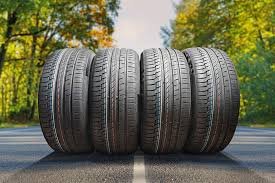
When selecting tires for your vehicle, understanding the differences between various sizes is crucial, as each dimension impacts performance, comfort, and handling in distinct ways. In this comparison, we’ll take a closer look at the 275 / 50 R22 and 255 / 35 R18 tire sizes, exploring how they differ in terms of grip, comfort, fuel efficiency, and their ideal applications.
Breaking Down Tire Specifications
Let’s first break down the numbers and letters in these tire sizes to understand what they represent.
275 / 50 R22
- 275: This number indicates the tire’s width in millimeters. At 275 mm, this is a wide tire, offering substantial road contact and grip, often seen on larger vehicles like trucks and SUVs.
- 50: The aspect ratio, or the height of the sidewall, is 50% of the 275 mm width. This makes the sidewall relatively tall, which helps absorb road impacts and improves comfort.
- R: This indicates radial construction, the standard for most modern tires.
- 22: This tire is designed for 22-inch wheels, typically found on large trucks, luxury SUVs, and high-end performance vehicles.
255 / 35 R18
- 255: This number refers to the tire’s width in millimeters. At 255 mm, this is also a wide tire, though slightly narrower than the 275 mm option. It is commonly used on performance sedans, sports cars, and some smaller SUVs.
- 35: The aspect ratio is 35% of the 255 mm width, resulting in a low-profile tire with a short sidewall. Low-profile tires enhance handling but may compromise ride comfort over uneven surfaces.
- R: Like the 275 / 50 R22, this tire also features radial construction.
- 18: This tire is designed to fit 18-inch wheels, which are common on performance sedans, coupes, and smaller performance SUVs.
Advantages of 275 / 50 R22 Tires
The 275 / 50 R22 tire size is primarily found on larger vehicles like trucks, luxury SUVs, and performance-oriented SUVs. Here are the key advantages:
- Excellent Grip and Stability: With a width of 275 mm, these tires provide a large contact patch, enhancing road grip and stability. This size is ideal for heavier vehicles, offering better traction in various driving conditions, including off-road scenarios.
- Smooth Ride: The 50% aspect ratio gives these tires a relatively tall sidewall, which improves comfort by absorbing road impacts. This makes for a smoother ride, especially on rough or uneven surfaces.
- Ideal for SUVs and Trucks: These tires are built to handle the weight and power of larger vehicles, providing stability and durability even at higher speeds or when carrying heavy loads. They are also capable of handling light off-road driving.
- Aesthetically Bold: The 22-inch wheels combined with wide tires offer an aggressive and stylish appearance. Larger wheels are popular for enhancing the visual presence of trucks and SUVs.
Advantages of 255 / 35 R18 Tires
The 255 / 35 R18 tire size is designed for performance vehicles, focusing on handling, responsiveness, and road feedback. Here are its key benefits:
- Superior Handling and Precision: The 255 mm width provides a wide contact patch, improving road grip and cornering abilities. The 35% aspect ratio and low-profile design enhance the tire’s responsiveness, making it ideal for sharp handling and high-speed driving.
- Enhanced Performance: With a lower sidewall, these tires reduce sidewall flex during aggressive driving, offering better control during cornering and high-speed maneuvers. They are perfect for sports cars and performance sedans where handling and road feedback are critical.
- Sporty Aesthetics: The 18-inch wheels and low-profile design give the vehicle a sporty and sleek appearance. These tires are often chosen for vehicles where performance and aesthetics are equally important.
- More Affordable: Compared to larger tires like 275 / 50 R22, the 255 / 35 R18 tires are generally more affordable and easier to find. They are common on performance sedans and coupes, making replacements relatively cost-effective.
Key Differences Between 275 / 50 R22 and 255 / 35 R18
1. Width and Traction
- The 275 mm width of the 275 / 50 R22 tire offers a slightly larger contact patch than the 255 mm width of the 255 / 35 R18 tire. This gives the 275 / 50 R22 tire better traction, especially for larger, heavier vehicles like SUVs or trucks.
- The 255 / 35 R18 tires, while narrower, are still wide enough to provide excellent grip, particularly for performance-oriented driving. These tires are optimized for speed and cornering rather than heavy-duty traction.
2. Ride Comfort
- The 50% aspect ratio of the 275 / 50 R22 tire offers a taller sidewall, which enhances ride comfort by absorbing bumps and road imperfections. This makes these tires better suited for longer drives, off-road use, and carrying heavy loads.
- The 35% aspect ratio of the 255 / 35 R18 tire results in a much lower sidewall, which prioritizes handling over comfort. The shorter sidewall can result in a stiffer, less cushioned ride, especially on uneven surfaces.
3. Handling and Performance
- The 255 / 35 R18 tires are specifically designed for precision handling, offering superior road feedback and control. They are ideal for sports cars, performance sedans, and vehicles where high-speed cornering and responsiveness are important.
- The 275 / 50 R22 tires, while still providing good stability, are not as performance-focused as the 255 / 35 R18. They are better suited for larger vehicles where comfort and stability are prioritized over sharp handling.
4. Fuel Efficiency
- The 255 / 35 R18 tires, being smaller and narrower, generally have lower rolling resistance compared to 275 / 50 R22 tires. This makes them more fuel-efficient, especially in performance vehicles designed for speed.
- The 275 / 50 R22 tires, with their larger size and wider footprint, create more rolling resistance. This can result in decreased fuel efficiency, particularly on larger trucks and SUVs.
5. Aesthetic Appeal
- The 275 / 50 R22 tires, with their large size and 22-inch wheels, offer a bold, aggressive look that is popular among SUV and truck owners. They enhance the vehicle’s road presence and give it a rugged, commanding appearance.
- The 255 / 35 R18 tires have a sleeker, sportier appearance, which is well-suited for performance sedans, sports cars, and vehicles with a focus on speed and agility.
6. Off-Road Capability
- The 275 / 50 R22 tires are more versatile for off-road or mixed driving conditions. Their taller sidewalls and wider width make them better suited for uneven terrain, providing more cushion and protection for the wheels.
- The 255 / 35 R18 tires are not ideal for off-road use. Their low-profile design and shorter sidewalls make them more vulnerable to damage on rough terrain and offer little shock absorption over uneven surfaces.
Which Tire is Right for You?
Choose 275 / 50 R22 if:
- You drive a larger vehicle, such as an SUV or truck, and prioritize ride comfort, stability, and the ability to handle a variety of road conditions, including light off-roading.
- You want a tire that offers a bold, aggressive look with large 22-inch wheels, making a statement both on the road and off.
- You need tires capable of carrying heavier loads while maintaining comfort and grip.
Choose 255 / 35 R18 if:
- You drive a performance sedan, sports car, or smaller performance SUV where handling, precision, and road feedback are critical.
- You prioritize superior control and cornering abilities over comfort, especially if you frequently drive at high speeds or on winding roads.
- You prefer a sleek, sporty appearance with low-profile tires that complement the design of a performance vehicle.
Final Thoughts
The 275 / 50 R22 and 255 / 35 R18 tires are designed for very different types of vehicles and driving styles. The 275 / 50 R22 tires are perfect for larger vehicles like SUVs and trucks, offering a comfortable, stable ride with enhanced off-road capability. They provide excellent traction and stability for heavy-duty applications but may sacrifice fuel efficiency. In contrast, the 255 / 35 R18 tires are focused on performance, offering superior handling and road feedback for sports cars and performance sedans. They excel in high-speed driving and cornering but are less suited for rough terrain or heavy loads.
Choosing the right tire depends on your vehicle type, driving habits, and priorities—whether it’s comfort, performance, aesthetics, or versatility.



